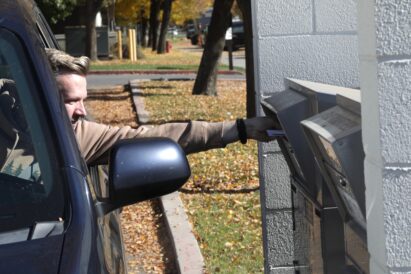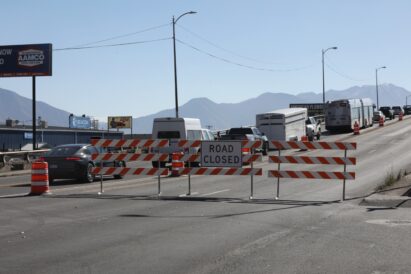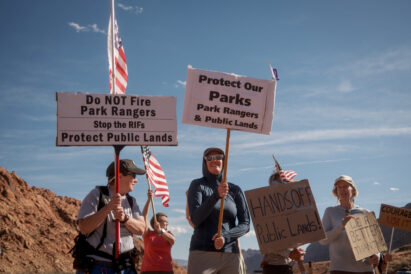As Utah’s national parks stay open, so do questions about the shutdown’s impact
Visitors in Moab say their experience has been smooth, but a former park ranger raises concerns

Photo by Spenser Heaps for Utah News Dispatch
Former park ranger Allyson Mathis, left, and others protest the government shutdown outside the entrance to Arches National Park in Moab on Monday, Oct. 27, 2025.Staring up at towering red rocks, Julie Maager and Kate Mueller felt fortunate on Friday.
Just a few weeks ago, the two friends from Wisconsin weren’t sure they’d get to see Arches National Park during the federal government shutdown, let alone arrive to find the bathrooms clean and the visitor center open.
“As a visitor, I’m just delighted,” said Maager, 53.
“Go Utah!” said Mueller, 65.
The state is pumping $8,000 a day into keeping its five national parks running at a limited capacity, joining nonprofits in financially supporting the parks.
While visitors may not notice a significant impact in the short term, others say the shutdown is holding parks and their staff back from meeting their mission to preserve the land and serve the public.
At the latest in a series of protests in Moab on Friday, a small group vented their frustration and fears as more than 9,000 National Park Service employees — the majority of its workforce — remain furloughed across the country, and others are working without pay.
“Bare bones staff picking up trash isn’t meeting the mission, and visitors aren’t having the experience they should have,” said Allyson Mathis, a former park ranger at Canyonlands, Capitol Reef and Grand Canyon national parks.
The 1916 law creating the National Park Service set its mission to “preserve unimpaired” its resources “for the enjoyment, education, and inspiration of this and future generations.”
But with agency scientists sidelined, Mathis said one key element of preserving the parks — the usual fall monitoring of plants and wildlife — have been paused indefinitely. So have many administrative functions and the most informational talks available to visitors.
Also among the protesters’ concerns: staffing for next year’s busy season. Utah’s parks typically start posting those upcoming seasonal jobs in November and December, but that isn’t likely to happen in the shutdown.
Mathis compared the mechanics of running a national park to another complex system requiring immense administrative support that’s often unseen.
“To run a hospital, you need more than just the docs and the nurses on the front line to save lives. You have to have all the techs. You have to have people buying the supplies and the materials and administration,” Mathis said.
At Zion National Park, a nonprofit is stepping in to help. Visitors are using maps and other printouts paid for by the Zion Forever Project, at a cost of $30,000. The group is also chipping $20,000 to staff an information desk during the closure.
Zion Forever contributes a yearly average of $3.3 million to the park, and the number will likely go up this year since parks aren’t collecting visitor fees while the federal government’s closed, said Natalie Britt, president and CEO. Britt noted October is one of the park’s busiest months.
“When those fees stop coming in, the impact is immediate and far-reaching,” Britt said in an email Friday.
In Moab, Mali Sanders, 25, joined about 15 other protesters on Main Street Friday, holding a small American flag.
With fewer park rangers at work, she’s concerned visitors will feel emboldened to leave a mess and that their bad behavior could go unchecked. She saw that happen in Joshua Tree National Park during the 35-day government closure in December 2018.
“I was watching people let their dogs run loose, not pick up dog poop, trashing things,” Sanders said. “It was kind of a disaster. They were treating a national park the way that high schoolers treat a party spot.”
Protesters also raised concerns about the ongoing financial toll on workers going without pay, concerns echoed by Maager and Mueller. The two friends said they want to see the state’s parks and its staff stay in good shape for years to come.
“They are so emblematic of not only Utah, but the West and America,” Mueller said. “To put them in any kind of peril, any kind of jeopardy, is unthinkable.”



